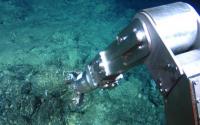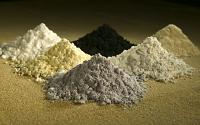Revision of Deep seabed mining has potential to be significant source of strategically valuable rare earth elements from Thu, 04/29/2021 - 12:52
U.S. companies increasingly seek to engage in seabed mining for minerals such as rare earth elements and cobalt that are critical to the broad U.S. economy and used in producing defense assets. The deep seabed contains two potential sources for rare earth elements: polymetallic nodules which typically contain manganese, nickel, copper, cobalt and rare earth minerals; and sea-floor hydrothermal vents which pump out rare-earth elements dissolved in their hot fluids.
Quicktabs: Arguments
It has long been known that the ocean might provide a wealth of rare earths. Sea-floor hydrothermal vents pump out rare-earth elements dissolved in their hot fluids. And these elements and others accumulate in potato-sized lumps, called manganese nodules, on the sea floor. The elements also build up in sea-floor mud; but only a few spot measures of this source of rare-earth elements have previously been made.
Kato and his colleagues set out to perform a widespread assessment of this possible resource. They looked at 2,000 samples of sediments taken from 78 sites around the Pacific, and found rare-earth concentrations as high as 0.2% of the mud in the eastern South Pacific, and 0.1% near Hawaii. That might not sound like much, but those concentrations are as high as or higher than those at one clay mine currently in operation in China, they point out. And the deposits are particularly rich in heavy rare-earth elements — the rarer and more expensive metals.
Some of the deposits are more than 70 metres thick. The authors estimate that an area of 1 square kilometre around a hotspot near Hawaii could hold 25,000 tonnes of rare earths. Overall, they say, the ocean floor might hold more than the 110 million tonnes of rare earths estimated to be buried on land.
Seabed mining, in the Arctic and elsewhere, is also becoming an important strategic interest for the United States. U.S. companies increasingly seek to engage in seabed mining for minerals such as rare earth elements and cobalt that are critical to the broad U.S. economy and used in producing defense assets. However, as long as the United States remains outside the international legal protections afforded by LOSC, the private sector remains hesitant to invest in seabed mining – investments that would reduce U.S. vulnerabilities to external pressure and supply disruption. Indeed, since few suppliers provide such minerals and they are prone to intentional or unintentional disruptions and price spikes, increasing U.S. production will help prevent suppliers from exerting political and economic leverage over the United States and its allies.22
India has joined the race to explore and develop deep-sea mining for rare earth elements — further complicating the geopolitics surrounding untapped sources of valuable minerals beneath the oceans. The country is building a rare-earth mineral processing plant in the east coast state of Orissa and it is spending around US$135 million to buy a new exploration ship and to retool another for sophisticated deep-water exploration off its coast. The Central Indian Basin, for example, is rich in nickel, copper, cobalt and potentially rare-earth minerals, which are highly lucrative and used widely in manufacturing electronics such as mobile phone batteries. They are found in potato-shaped nodules on the deep-sea floor. "These nodules offer a good solution to meeting the nation's demand for metals," C. R. Deepak, head of the deep-sea mining division at the National Institute of Ocean Technology (NIOT), Chennai, told SciDev.Net.
The world economy, still suffering from the financial crisis, is currently experiencing increasing commodity prices. Industrial associations and governments are monitoring patterns of supply and demand, not only for standard minerals like iron, but also for high-value metals (e.g., nickel, copper, titanium, gold) and rare earth elements (REE) like yttrium, indium, gallium, neodymium, and germanium (Kato et al. 2011) which are important for semi-conductors, photovoltaics, lasers, liquid crystal displays, fiber- optic cables, and other high-tech products used in both civilian and military applica- tions. The demand for raw materials is expected to double in the next 25 years. The EU has identified a list of 14 out of 41 critical raw materials2 which are irreplaceable in key industries. The supply risk is due to the fact that a high share of production comes from China,3 Russia, South Africa, the Democratic Republic of Congo, and Brazil. This production concentration cannot easily be substituted for or augmented by other sources. The political–economic stability of some of the producing states is questionable and, in the case of Congo, nearing collapse. The list of failing states will grow where humanitarian and environmental risks may get completely out of control. The risks for the supply chains are self-evident: old and newly industrialized states are competing over prices and access rights to the remaining raw materials, while the low-hanging fruits have been picked. As a consequence, interest in marine mineral resources is growing again. With only 29% of the world's surface being land and 71% being sea, there is every reason to believe that terrestrial minerals occur in deposits on and in the seabed, as well. The Pacific Ocean alone is larger than all land masses on earth.
Until a decade ago, the United States was 100 percent self-reliant for rare earth production, with domestic companies producing enough to supply U.S. manufacturers. Over time, however, U.S. production was halted as it became economically and environmentally cost prohibitive.
Companies in various countries – including the United States – are looking at reopening closed mines and developing new deposits, but these efforts could take a number of years to fully come on line.
The deep seabed offers a new opportunity for the United States to gain steady access to these vital rare earth minerals. Polymetallic nodules are located on the deep ocean floor. These nodules typically contain manganese, nickel, copper, cobalt and rare earth minerals. However, U.S. companies cannot actively pursue claims in the areas where these nodules are dense unless the U.S. ratifies the Law of the Sea Treaty.
The United States needs to invest in off-shore drilling for its national defense: "The U.S. requires an incredible number of military products for which rare earth minerals [which are found in abundance in the seabed] are essential.”116The Case for Ratification of the Law of the Sea Treaty — Andrew Langer. — Real Clear Politics — Nov 28, 2012 [ More ] In the past, military products were manufactured in the United States.117The Case for Ratification of the Law of the Sea Treaty — Andrew Langer. — Real Clear Politics — Nov 28, 2012 [ More ] Today, a "tremendous number of our bullets are manufactured in China ... meaning that if we find ourselves cross-wise with the Chinese, they can cut off our supply of bullets.118The Case for Ratification of the Law of the Sea Treaty — Andrew Langer. — Real Clear Politics — Nov 28, 2012 [ More ] It is a matter of national security that the United States be self-reliant on ammunition for its weapons."119The Case for Ratification of the Law of the Sea Treaty — Andrew Langer. — Real Clear Politics — Nov 28, 2012 [ More ] The United States needs to accede to UNCLOS to give companies the security to invest in offshore drilling, in order to be able to manufacture bullets independently from its own supply of rare minerals.120The Case for Ratification of the Law of the Sea Treaty — Andrew Langer. — Real Clear Politics — Nov 28, 2012 [ More ]
Advances in deep sea resource exploration and exploitation technologies have also given rise to the prospect of accessing seabed resources not only within areas of outer continental shelf but in deeper waters and areas beyond national jurisdiction. While developments in the area are proceeding apace, notably in respect of the Clarion-Clipperton Zone in the Equatorial North Pacific Ocean and in the Central Indian Basin of the Indian Ocean,n areas of outer continental shelf subject to national jurisdiction are likely to be particularly attractive areas for development from the perspective of the coastal states, which hold sovereign rights over these areas. Indeed, it has been estimated that the Clarion-Clipperton Zone alone holds more than 27 billion tonnes of nodules containing of the order of 7 billion tonnes of manganese, 340 million tonnes of nickel, 290 million tonnes of copper and 78 million tonnes of cobalt as well as rare earths needed for the production of many hi-tech products such as smart phones.78 This led the International Seabed Authority's (ISA) Legal Counsel, Michael Lodge, to comment in May 2013 that "We are on the threshold of a new era of deep seabed mining."79 While the figures suggested may appear extraordinary, there seems little doubt that interest in the exploitation of these resources will be sustained so long as commodity prices remain high. The ISA's approval of exploration plans for the development of cobalt-rich manganese crusts by Chinese and Japanese concerns during its nineteenth session in July 2013 also appears to bear out the seriousness of this interest.80

The author argues that one way the Biden Administration could meet its goal of shoring up the supply of critical rare earth metals is by signing the Law of the Sea convention, opening up the deep seabed for commerical exploitation.
[ More ]
The authors argue in favor of mining the deep seabed, looking at how it fares comparably to land-based mining and how it will meet demand for key metals for electric vehicles and green technology.
[ More ]
The risk of running out of rare earth metals that are essential to modern technology has led to a surge in interest in mining the deep seas.
[ More ]
Scientists looking for deep sea organisms on a research cruise last month got a surprise when, instead of deep sea life, they pulled up metal balls the size of softballs. The German researchers stumbled inadvertently onto the discovery of the largest deposit of manganese nodules known to exist in the Atlantic ocean.
[ More ]
Japan keeps finding treasure in deep-sea mud. For the second time in two years, a Japanese team has announced vast deposits of rare earth elements on the floor of the Pacific Ocean.
[ More ]
The author argues that if the U.S. wants to increase its access to Rare Earth Elements make domestic mining a more attractive investment then the Senate should ratify the Law of the Sea Treaty.
[ More ]
China is using government funds to stockpile rare earth minerals amid concerns its reserves are running low, a state newspaper has reported. According to the China Securities Journal the stockpiling is already well underway, and most likely began a while before the country published a white paper on 20 June announcing the extent of its dwindling supplies and suggesting it would build a strategic reserve.
[ More ]
Vast deposits of rare earth minerals, crucial in making high-tech electronics products, have been found on the floor of the Pacific Ocean and can be readily extracted, Japanese scientists said on Monday.
[ More ]
Japanese researchers say they have discovered vast deposits of rare earth minerals, used in many hi-tech appliances, in the seabed. The geologists estimate that there are about a 100bn tons of the rare elements in the mud of the Pacific Ocean floor.
[ More ]
For decades, entrepreneurs have tried to strike it rich by gathering up the manganese nodules that carpet the global seabed but until now they have not been able to prove the economic viability of these ventures. The nodules turn out to contain so-called rare-earth minerals — elements that have wide commercial and military application but have hit a production roadblock.
[ More ]